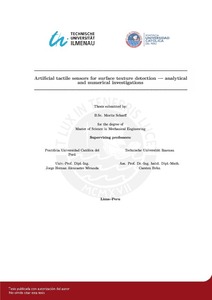| dc.contributor.advisor | Alencastre Miranda, Jorge Hernán | |
| dc.contributor.advisor | Behn, Carsten | |
| dc.contributor.author | Scharff, Moritz | es_ES |
| dc.date.accessioned | 2017-02-07T21:07:35Z | es_ES |
| dc.date.available | 2017-02-07T21:07:35Z | es_ES |
| dc.date.created | 2016 | es_ES |
| dc.date.issued | 2017-02-07 | es_ES |
| dc.identifier.uri | http://hdl.handle.net/20.500.12404/7720 | |
| dc.description.abstract | Natural vibrissae fulfill a lot of functions. Next to object distance detection and object shape recognition, the surface texture can be determined. Inspired by the natural process of surface texture detection, the goal is to adapt it by technical concepts. Modeling the vibrissa as an EulerBernoulli bending beam and the vibrissa-surface contact with respect to Coulomb's Law of Friction, the first approach is formed by the group of Steigenberger and Behn. Due to the surface contact, the vibrissa gets deformed. Initiating a linear movement of the beam support in the way that the bearn tip gets pushed, first the beam tip is sticking to the surface. The acting friction force prevents a movement of the beam tip until the static friction coeflicient is reached. The displacement of the support corresponds to changes in the acting forces and moment. Out of these changes the coeflicient of static friction can be determined. Advancing the present model, the effects of an elastic support, a conical shape of the considered beam, a natural pre-curved (stress free) beam and an inclined contact plane on the resulting forces and moments are analyzed in an analytical way, and then discussed by numerical simulations in performing parameter studies. All these special features of the beam as a tactile sensor are successfully studied. The results for the conical beam shape are only of theoretical relevance. In a next step, a quasi-static model is compared to experimental data to verify the concept. The displacement is represented by a linear, stepwise change of the support of the sensor. By image processing the deformations of the beam for every support position are analyzed. This information is compared to the simulation. The concept in principal is confirmed by the experiments. | es_ES |
| dc.description.uri | Tesis | es_ES |
| dc.language.iso | eng | es_ES |
| dc.publisher | Pontificia Universidad Católica del Perú | es_ES |
| dc.rights | info:eu-repo/semantics/openAccess | es_ES |
| dc.rights.uri | http://creativecommons.org/licenses/by-nc-nd/2.5/pe/ | * |
| dc.subject | Sensores táctiles | es_ES |
| dc.subject | Reconocimiento de imágenes | es_ES |
| dc.title | Artificial tactile sensors for surface texture detection - analytical and numerical investigations | es_ES |
| dc.type | info:eu-repo/semantics/masterThesis | es_ES |
| thesis.degree.name | Maestro en Ingeniería Mecánica | es_ES |
| thesis.degree.level | Maestría | es_ES |
| thesis.degree.grantor | Pontificia Universidad Católica del Perú. Escuela de Posgrado | es_ES |
| thesis.degree.discipline | Ingeniería Mecánica | es_ES |
| renati.advisor.dni | 10588073 | |
| renati.advisor.orcid | https://orcid.org/0000-0001-8442-8255 | es_ES |
| renati.discipline | 713347 | es_ES |
| renati.level | https://purl.org/pe-repo/renati/level#maestro | es_ES |
| renati.type | http://purl.org/pe-repo/renati/type#tesis | es_ES |
| dc.publisher.country | PE | es_ES |
| dc.subject.ocde | https://purl.org/pe-repo/ocde/ford#2.03.01 | es_ES |






